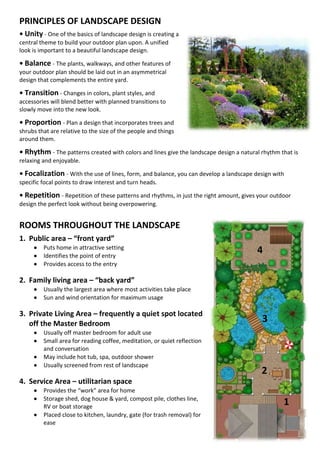Landscape Design Can Be Fun For Everyone
Landscape Design Can Be Fun For Everyone
Blog Article
Landscape Design Fundamentals Explained
Table of ContentsLandscape Design Things To Know Before You Get ThisSome Known Details About Landscape Design The Definitive Guide for Landscape DesignAbout Landscape Design
Formal design motif. Credit Report: Gail Hansen, UF/IFAS The yard is an expansion of the home where a variety of tasks happen. A backyard can usually be divided into 3 areas: public (the front backyard), private (the back backyard), and solution (usually the side lawn). The area of activity locations depends largely on the sort of location, the dimension of room required, the type of activity, and the wanted closeness to other tasks and frameworks (Landscape Design).
The outdoors wall of your home usually functions as the very first wall or beginning factor of an outdoor room. Incompatible usages must be separated, and relevant tasks, such as food preparation and dining, need to be placed with each other to make the yard a lot more efficient and satisfying. When utilizing hardscape to develop rooms, use construction product similar to that made use of in your home for connection from the home right into the yard.
Linked areas. Credit Score: Gail Hansen, UF/IFAS Making use of similar hardscape features and duplicating plants draws the eye around the yard. Vital points along the means can be stressed with growings or functions that attract focus and urge movement in a particular instructions. Moving along the path takes an individual from one area to the following and allows the customer to have a selection of experiences.
From a style perspective, plant products have three significant features in the landscape: aesthetic, structural and utilitarian. Cosmetically, plants create an aesthetically positive environment and structurally plants arrange and specify spaces.
The Main Principles Of Landscape Design
For psychological convenience plants are used as physical or suggested barriers for privacy and safety. Physical obstacles obstruct both the view and access to an area and consist of fences, wall surfaces and plant hedges. Landscape Design. Suggested obstacles, commonly low growing plants, block accessibility yet not the sight (Number 9). Other functions of plants include cleansing the air, stopping erosion and dirt loss, retaining dampness in the soil, and returning raw material to the dirt.
Physical and indicated obstacles. Credit Rating: Gail Hansen, UF/IFAS For these factors, the kinds of plants to be utilized (such as trees, hedges, or groundcovers) must be selected in the onset of preparation. Plant kinds are chosen for their useful abilities to ensure that their future purpose and required room can be taken into consideration at the very same time.
The overhead airplane, the upright aircraft and the ground plane must all be thought about to create enclosure. When the shape of a plant bed has been developed, the plants must be massed (grouped) and layered to achieve aesthetic unity and the preferred amount of unit. The size of a plant mass will rely on the complete size of the lawn, the dimension of the specific plants in the mass, and the emphasis or influence wanted from the plant product.
Each plant mass remains in front of, behind, important link or alongside, an additional mass. Number 11. Horizontal plant layers. Credit Report: Gail Hansen, UF/IFAS Figure 12. Vertical plant layers. Debt: Gail Hansen, UF/IFAS Repeating plants within a mass and duplicating masses with comparable plants connects the garden with each other. The specific plant features have to be thought about to efficiently layer and mass plants.
Indicators on Landscape Design You Should Know
All plant make-ups begin with the major check structure plants, the big, primarily evergreen background plants-such as the trees and large bushes. These plants separate or enframe rooms, control the dimension of the space, and provide the starting point for picking the proper characteristics of the 2nd layer, midground plants, for massing and infill.
Vital factors in the garden ought to be highlighted by the usage of special plants, distinct structures, or garden accessories. Noting thresholds or entryways to areas can be performed with gateways, arbors, and actions, or via using special and colorful plants. The form and/or style theme of the garden will commonly help identify the vital points and exactly how they ought to be highlighted.
Various other important areas in the backyard are focal factors, which is used to visually arrange a landscaped location. Different perspectives or viewpoints can reveal different compositions in the landscape that might call for a variety of focal factors.
Landscape Design Fundamentals Explained
Plant types. Credit Scores: Gail Hansen, UF/IFAS After kind, structure is the next leading feature of a plant; coarse, medium and fine structures click for more can be used for comparison and emphasis in the landscape.


The pleasurable fragrance of plants, the audio of wind in the trees, the audio and structure of water, and the colors and appearances of sculptures, pots and garden furnishings all add to the experience of the garden. One information that is commonly forgotten is the result of light on the appearances of the plants.
The entire garden modifications in feature and look throughout the day, and the course of a year, as the light and temperature change from morning to night and period to season. Plant option should take into consideration a plant's growth price, its fully grown dimension and kind, and the upkeep it will certainly call for.
It is essential to recognize the eventual fully grown size of plants so they can be placed in the right area and spaced appropriately when they are set up. Giving plants area to expand is a difficulty due to the fact that the usual mature dimension is commonly based upon ideal expanding problems and the environmental problems of a site might create a plant to enlarge or remain smaller.
Report this page